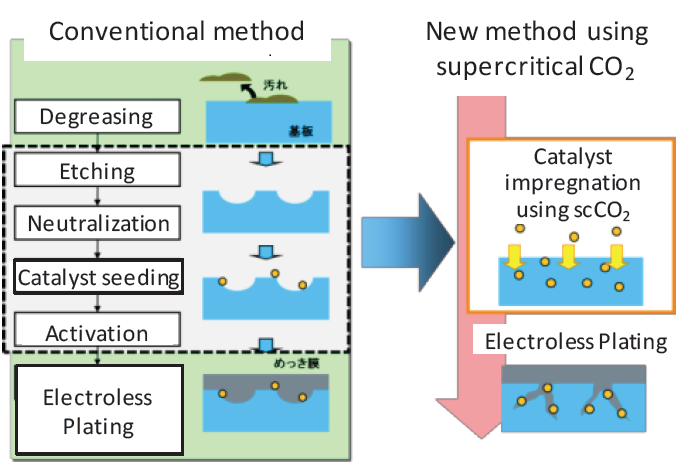Nanocellular Foam
In recent years, nanoscale, porous, structured polymer materials have attracted significant attention. We have been working on develop-ment of nanocellular foams (NCFs) of thermoplastic resins foamed by CO2 or N2 gas. Fig. 1 shows a polypropylene foam fabricated by N2 foaming with a crystal nucleating agent using core-back injection molding. Nanofibril structures are formed on the cell walls (Inset). The split of crystal lamellae induced by the bubble formation at the crystal phase resulted in the formation of such nanofibrils.
Environmentally-benign Electroless Plating
The conventional electroless plating on plastic resins requires the use of strong acid and a large amount of water to impregnate the plastic with catalyst. We have been developing a new environmentally-benign electroless plating process using supercritical CO2 that dissolves the precursor of catalyst and plasticizes the resin (Fig. 2). Although this method is available on nylon that is relatively hydrophilic, the formation of strongly adhered meltal layer on hydrophobic polymers is still challenging. Recently we succeeded in the electroless plating on strongly hydrophobic polypropylene by blending it with a hydrophilic copolymer (Fig. 3).
Nanofibers by Electrospinning
Electrospinning is a simple method for producing polymer nanofibers by applying a high voltage to the polymer solution. We have been studying on the fabrication of ceramic, carbon, and composite nanofibers with core-shell or porous structure. Fig. 4 shows SEM image of mesoporous carbon nanofibers using a surfactant as a template. The mesopore structure is thought to be advantageous to the ion transport when used as an electrode of electric double layer capacitor.




